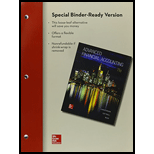
What are the nonjudicial actions available to a financially distressed company? What judicial actions are available?
Introduction : Bankruptcy is the final step for a financially distressed business. Prior to that, management usually tries to work closely with the company’s creditors to provide for their claims while attempting to ensure the firm’s continuing experience. Various non-judicial arrangements with creditors are available. If these fail, the company usually ends up with a judicial action under the direction of a bankruptcy court.
The non-judicial actions available to a financially distressed company as well as judicial actions also.
Answer to Problem 20.1Q
Non − judicial actions − These are the formal agreements between the company and its creditors which are legally required but are not administered by a court.
Judicial actions − Bankruptcy is a judicial action administered by bankruptcy judges and bankruptcy courts using the guidance provided in the Title 11 of the U.S Bankruptcy Code. This bankruptcy code provides the essential structure for bankruptcy proceedings but periodically, U.S Court has amended it.
Explanation of Solution
Non-judicial actions are as follows −
- Debt Restructuring Arrangements − These are arrangements between a debtor company and one or more of its creditors in temporary financial difficulty. The debtor may ask for an extension of due dates of its debt, ask for a decrease of the interest rate on the debt, or ask for a modification of other terms of the debt contract. Many banks prefer to continue to work with a customer who is in temporary financially difficulty rather than force it into bankruptcy.
- Creditors Committee Management − Under creditor’s committee management, the creditors may have the same opinion to help the debtor in managing the most efficient payment of its claims. Most creditors’ committees give advice and closely counsel the debtor because the creditors do not want to assume additional liabilities and troubles of the debtor’s actual operation. Forming a creditors committee is a non-judicial action usually initiated with a plan of settlement proposed by the debtor.
- Transfer of Assets − Some debtors in financial difficulty may transfer assets such as receivables or other financial assets in order to obtain quick cash. For example, debtors that need cash may issue their trade receivables at a discount and the contract may specify that the receivables be sold with recourse or without recourse.
Another form of debt restructuring arrangement is the composition agreement. In this case, creditors agree to accept less than the face amount of their claims. The advantage to the creditors is that they receive an immediate cash payment and usually negotiate the timing of the remaining cash payments. Although the creditors receive less than the full amount, they are assured of receiving most of their receivables.
Judicial actions are as follows -
- Bankruptcy - It is a judicial action administered by bankruptcy judges and bankruptcy courts using the guidance provided in the Title 11 of the U.S Bankruptcy Code. This bankruptcy code provides the essential structure for bankruptcy proceedings but periodically, U.S Court has amended it.
The bankruptcy code is composed of eight chapters. Chapter 1, 3 and 5 present the definitions and operating provisions of the bankruptcy code, Chapters 7 and 11 deals with corporate bankruptcies. Chapter 9 covers municipal governments and Chapters 12 and 13 provide guidance for individual bankruptcies.
Want to see more full solutions like this?
Chapter 20 Solutions
LOOSE-LEAF ADVANCED FINANCIAL ACCOUNTING
Additional Business Textbook Solutions
Financial Accounting (11th Edition)
Managerial Accounting (4th Edition)
Financial Accounting: Tools for Business Decision Making, 8th Edition
Financial Accounting, Student Value Edition (5th Edition)
Principles of Accounting Volume 2
PRINCIPLES OF TAXATION F/BUS.+INVEST.
- If a bankruptcy is deemed likely to occur and is reasonably estimated, what would be the recognition and disclosure requirements for the company?arrow_forwardWhat type of taxpayers (entities) are affected by the passive loss rules? What is the significance of a closely held corporation with regard to the deductibility of passive losses?arrow_forwardWhat is a deficiency judgment and how is its value to a lender affected by the Bankruptcy Code?arrow_forward
- If a corporation files bankruptcy and is liquidated, who should get paid first: the corporation’s bondholders or its stockholders? Why?arrow_forwardWhat informal remedies are available to firmsin financial distress? In answering this question,define the following terms: (6) Assignee (trustee)arrow_forwardWhat is feasibility (in bankruptcy)?arrow_forward
- Which of the following is an example of protective rights? Rights to appoint or remove another entity that directs the relevant activities The right of a party holding a non-controlling interest in an investee to approve the issue of equity or debt instruments Rights to veto any changes for the benefit of the investor All of the choicesarrow_forwardWould it be a sound rule to liquidate whenever the liquidation value is abovethe value of the corporation as a going concern? Discuss.arrow_forwardWhat are the Investing factors, Financing factors and Operating factors of bankruptcy?arrow_forward
 Intermediate Accounting: Reporting And AnalysisAccountingISBN:9781337788281Author:James M. Wahlen, Jefferson P. Jones, Donald PagachPublisher:Cengage LearningBusiness/Professional Ethics Directors/Executives...AccountingISBN:9781337485913Author:BROOKSPublisher:Cengage
Intermediate Accounting: Reporting And AnalysisAccountingISBN:9781337788281Author:James M. Wahlen, Jefferson P. Jones, Donald PagachPublisher:Cengage LearningBusiness/Professional Ethics Directors/Executives...AccountingISBN:9781337485913Author:BROOKSPublisher:Cengage Individual Income TaxesAccountingISBN:9780357109731Author:HoffmanPublisher:CENGAGE LEARNING - CONSIGNMENT
Individual Income TaxesAccountingISBN:9780357109731Author:HoffmanPublisher:CENGAGE LEARNING - CONSIGNMENT





